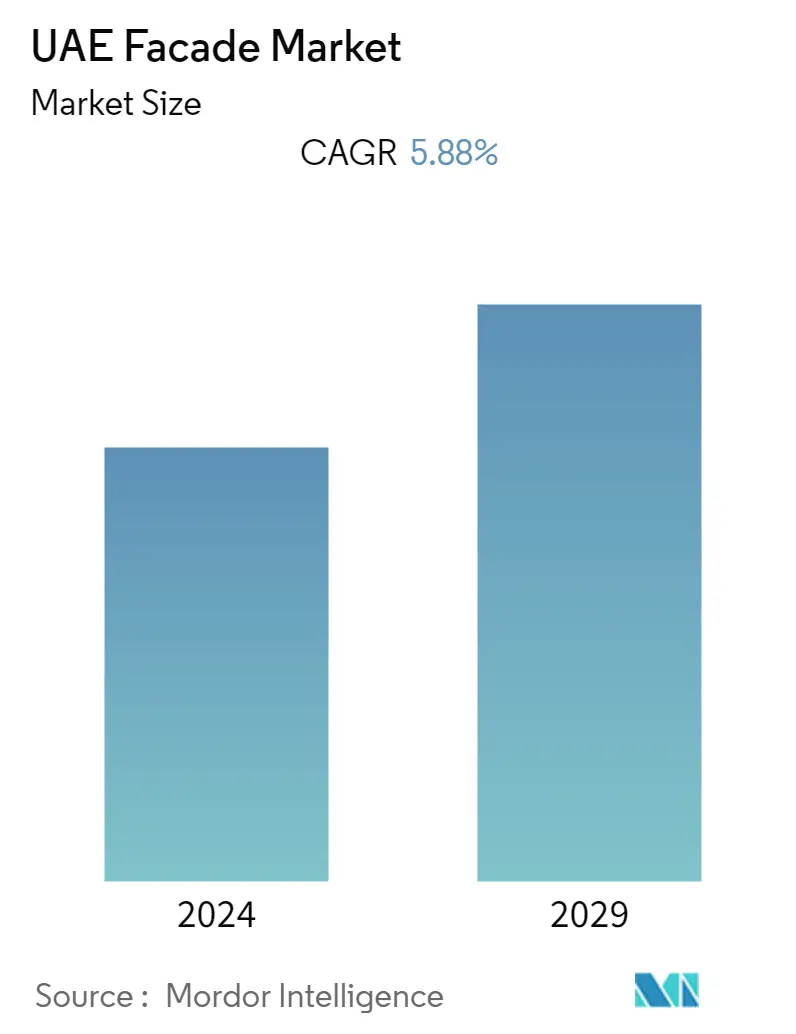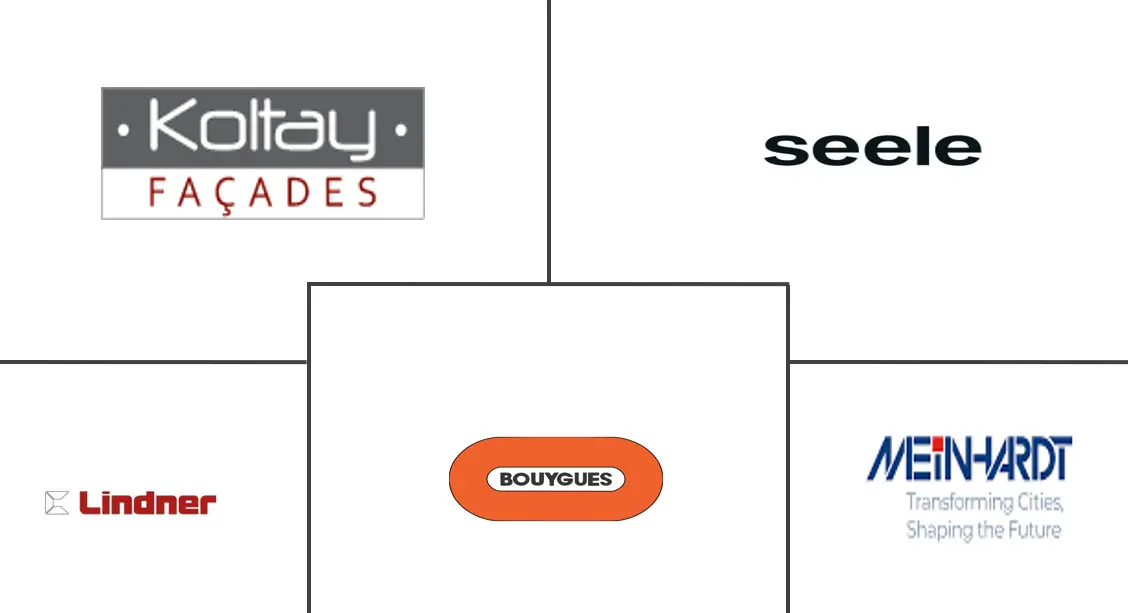Market Size of UAE Facade Industry

| Study Period | 2020 - 2029 |
| Base Year For Estimation | 2023 |
| Forecast Data Period | 2024 - 2029 |
| Historical Data Period | 2020 - 2022 |
| CAGR | 5.88 % |
| Market Concentration | Low |
Major Players
*Disclaimer: Major Players sorted in no particular order |
UAE Facade Market Analysis
The Size of the UAE Facade Market is USD 2.2 Billion in the current year and is anticipated to register a CAGR of more than 5.88% over the forecast period.
- The market is driven by the demand for fusion architecture that has a mix of both western and middle-eastern cultures. Furthermore, the market is driven by the advanced technology being used for the design and construction of these facades.
- Future façades are more likely to be adaptable. While incorporating flexible façades is critical for improving designs, it is also critical to incorporate automated designs that transform themselves simultaneously in response to interior and exterior conditions.
- Flexible shades adapt to varying meteorological conditions, protecting from solar radiation and maximising natural light without glare, changing their characteristics throughout the day and year in response to the environmental conditions at the Barjeel Art Museum in Sharjah, UAE for ultimate occupant comfort and energy consumption. The combination of flexible designs and automation will result in a more climate-ready, more resilient architecture while maintaining the interface's aesthetic impact.
- There is a growing demand for the use of fibre laser applications to improve water resistance, improve welding bonds, and prevent grain formation. The rain-screen system is another popular cladding technology. Because the air cavity connected to the load-bearing wall repels direct rain and moisture, the rain-screen cladding system provides consistent ventilation. We can see more electrochromic and self-cleaning glasses spread across the façades of high-rise buildings. This electric glass can be switched between translucent and transparent appearances to provide more privacy or access to more natural light. Users of the building can adjust the transmitted ultraviolet and natural light without glare. As a result, smart systems are being used to increase energy consumption.
- The Museum of the Future is a seven-story hollow silver ellipse decorated with quotes from Dubai's ruler in Arabic calligraphy. The museum is a seven-story hollow silver ellipse decorated with quotes from Dubai's ruler in Arabic calligraphy. It stands proudly on Sheikh Zayed Road, Dubai's main thoroughfare. In the evening, a colourful laser light show illuminated the building's striking facade as crowds gathered outside to catch a glimpse. It was later officially opened by Dubai's ruler, Sheikh Mohammed bin Rashid Al-Maktoum, whose vision of the future is credited with inspiring the Museum of the Future.
- Even though Muslims constitute approximately 80% of the UAE's population, the three Abrahamic religions (Islam, Christianity, and Judaism) are given equal weight at Abu Dhabi's new interreligious campus. The mosque, synagogue, and church of the project coexist imaginatively, occupying three indistinguishably cubic forms on a "secular" tourist pavilion. Although each of the three main buildings is oriented differently on the site, Ghanaian-British architect David Adjaye's firm, Adjaye Associates, claimed in its designs that it considered the connections of the faiths. In addition to prayer rooms, the complex aims to promote intercultural communication. To that end, a fourth area - an educational centre - will be a gathering place for all people of kindness.
UAE Facade Industry Segmentation
Any exterior wall of a structure, including projections from and attachments to the wall, is referred to as a facade. The UAE Façade Market is Segmented By Type (Ventilated, Non-Ventilated, and Others), By Material (Glass, Metal, Plastic and Fibres, Stones, and Others), and By End Users (Commercial, Residential, and Others). The report offers market size and forecast values (USD billion) for all the above segments.
| By Type | |
| Ventilated | |
| Non-Ventilated | |
| Others |
| By Material | |
| Glass | |
| Metal | |
| Plastic and Fibres | |
| Stones and Others |
| By End Users | |
| Commercial | |
| Residential | |
| Others |
UAE Facade Market Size Summary
The UAE facade market is experiencing significant growth, driven by the integration of advanced technologies and the demand for fusion architecture that blends Western and Middle-Eastern cultural elements. This market is characterized by the use of innovative materials and designs, such as flexible and automated facades that respond to environmental conditions, enhancing energy efficiency and occupant comfort. The adoption of smart systems, including electrochromic and self-cleaning glasses, is becoming more prevalent, contributing to the market's expansion. The market is also witnessing a shift towards sustainable and climate-resilient architecture, with projects like the Museum of the Future and the interreligious campus in Abu Dhabi showcasing the region's commitment to modern design and intercultural dialogue.
The UAE facade market is fairly fragmented, with a mix of regional, local, and a few global players dominating the landscape. Domestic companies hold a significant share due to their deep understanding of local architectural styles and traditions. Key players in the market include Inventure Metal Products Industries LLC, Synaxis Saveto LLC, and Dar Al Handasah (Shair & Partners) Consultants, among others. The market's growth is further supported by large-scale developments, such as the Red Sea International airport and Uptown Tower, which highlight the region's focus on sustainable construction practices. Despite the market's expansion, there are concerns about the volatility of the UAE real estate sector, with rising prices prompting cautious investment strategies.
UAE Facade Market Size - Table of Contents
-
1. MARKET INSIGHTS DYNAMICS
-
1.1 Current Market Scenario
-
1.2 Market Overview
-
1.3 Market Dynamics
-
1.3.1 Drivers
-
1.3.2 Restraints
-
1.3.3 Opportunities
-
-
1.4 Value Chain / Supply Chain Analysis
-
1.5 Industry Attractiveness - Porter's Five Forces Analysis
-
1.5.1 Threat of New Entrants
-
1.5.2 Bargaining Power of Buyers/Consumers
-
1.5.3 Bargaining Power of Suppliers
-
1.5.4 Threat of Substitute Products
-
1.5.5 Intensity of Competitive Rivalry
-
-
1.6 Government Regulations and Initiatives
-
1.7 Impact of COVID-19 on the Market
-
-
2. MARKET SEGMENTATION
-
2.1 By Type
-
2.1.1 Ventilated
-
2.1.2 Non-Ventilated
-
2.1.3 Others
-
-
2.2 By Material
-
2.2.1 Glass
-
2.2.2 Metal
-
2.2.3 Plastic and Fibres
-
2.2.4 Stones and Others
-
-
2.3 By End Users
-
2.3.1 Commercial
-
2.3.2 Residential
-
2.3.3 Others
-
-
UAE Facade Market Size FAQs
What is the current UAE Facade Market size?
The UAE Facade Market is projected to register a CAGR of 5.88% during the forecast period (2024-2029)
Who are the key players in UAE Facade Market?
Lindner Group, Meinhardt group, Bouygues SA, Seele Middle East FZE and Koltay Facades are the major companies operating in the UAE Facade Market.

